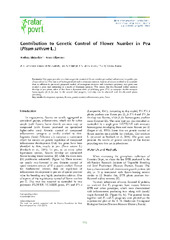| dc.creator | Sinjushin, Andrey | |
| dc.creator | Liberzon, Anna | |
| dc.date.accessioned | 2023-05-09T10:33:22Z | |
| dc.date.available | 2023-05-09T10:33:22Z | |
| dc.date.issued | 2016 | |
| dc.identifier.issn | 1821-3944 | |
| dc.identifier.uri | http://fiver.ifvcns.rs/handle/123456789/3493 | |
| dc.description.abstract | Our paper provides new data on genetic control of flower number per axillary inflorescence in garden pea (Pisum sativum L.). This trait is of both agricultural and evolutionary interest. Analysis of crosses enabled us to conclude that, in addition to previously proposed models of monogenic recessive and cumulative polymery, two genes can control a given trait interacting in a mode of dominant epistasis. This means that few-flowered axillary racemes develop in pea plants either if they bear a dominant allele of inhibiting gene (FN) or comprise double recessive homozygotes (fn fn fna fna). In the second filial progeny, 13:3 ratio can be observed with few-flowered plants prevailing. | sr |
| dc.language.iso | en | sr |
| dc.publisher | Novi Sad : Institute of Field and Vegetable Crops | sr |
| dc.rights | openAccess | sr |
| dc.rights.uri | https://creativecommons.org/licenses/by/4.0/ | |
| dc.source | Ratarstvo i povrtarstvo / Field and Vegetable Crops Research | sr |
| dc.subject | development | sr |
| dc.subject | epistasis | sr |
| dc.subject | flowers | sr |
| dc.subject | genetic control | sr |
| dc.subject | inflorescences | sr |
| dc.subject | peas | sr |
| dc.subject | Pisum | sr |
| dc.title | Contribution to Genetic Control of Flower Number in Pea (Pisum sativum L.) | sr |
| dc.type | article | sr |
| dc.rights.license | BY | sr |
| dc.citation.epage | 119 | |
| dc.citation.issue | 3 | |
| dc.citation.rank | M51 | |
| dc.citation.spage | 116 | |
| dc.citation.volume | 53 | |
| dc.identifier.doi | 10.5937/ratpov53-11949 | |
| dc.identifier.fulltext | http://fiver.ifvcns.rs/bitstream/id/9430/Sinjushin_Liberzon_2016_Ratar_Povrt.pdf | |
| dc.type.version | publishedVersion | sr |


